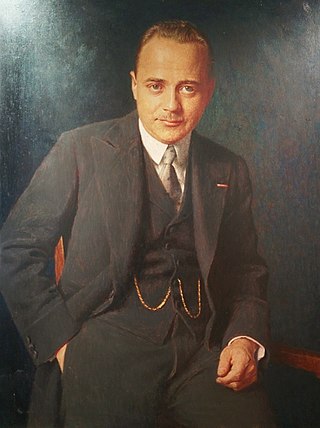
Engelbert Dolfuss was an Austrian politician who served as Chancellor and Dictator of Austria between 1932 and 1934. Having served as Minister for Forests and Agriculture, he ascended to Federal Chancellor in 1932 in the midst of a crisis for the conservative government. This crisis culminated in the self-elimination of the Austrian Parliament, a coup sparked by resignation of the presiding officers of the National Council. Suppressing the Socialist movement in the Austrian Civil War and later banning the Austrian Nazi Party, he cemented the rule of Austrofascism through the First of May Constitution in 1934. Later that year, Dollfuss was assassinated as part of a failed coup attempt by Nazi agents. His successor Kurt Schuschnigg maintained the regime until Adolf Hitler's Anschluss in 1938.

Lower Austria is one of the nine states of Austria, located in the northeastern corner of the country. Since 1986, the capital of Lower Austria has been Sankt Pölten, replacing Vienna, which became a separate state in 1921. With a land area of 19,186 km2 (7,408 sq mi) and a population of 1.685 million people, Lower Austria is the second-most-populous state in Austria. Other large cities are Amstetten, Klosterneuburg, Krems an der Donau, Stockerau and Wiener Neustadt.

Melk is a city in the Austrian state of Lower Austria, next to the Wachau valley along the Danube. Melk has a population of 5,257. It is best known as the site of a massive baroque Benedictine monastery named Melk Abbey.

Krems an der Donau is a town with 25,271 inhabitants end 2022 in Austria, in the federal state of Lower Austria. It is the fifth-largest city of Lower Austria and is approximately 70 kilometres west of Vienna. Krems is a city with its own statute, and therefore it is both a municipality and a district.

Leopold III, known as Leopold the Good, was the Margrave of Austria from 1095 to his death in 1136. He was a member of the House of Babenberg. He was canonized on 6 January 1485 and became the patron saint of Austria, Lower Austria, Upper Austria and Vienna. His feast day is 15 November.

Adalbert, known as Adalbert the Victorious, was the Margrave of Austria from 1018 until his death in 1055. He was a member of the House of Babenberg.
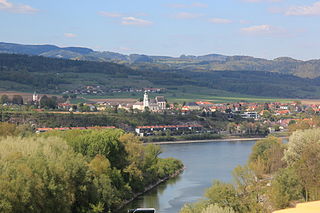
Bezirk Melk is a district of the state of Lower Austria in Austria.

A district is a second-level division of the executive arm of the Austrian government. District offices are the primary point of contact between residents and the state for most acts of government that exceed municipal purview: marriage licenses, driver licenses, passports, assembly permits, hunting permits, or dealings with public health officers for example all involve interaction with the district administrative authority.

The Piesting is a river in southern Lower Austria. A left tributary of the Fischa, its drainage basin is 348 km2 (134 sq mi).
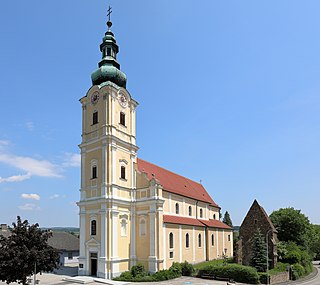
Loosdorf is a town in the district of Melk in the Austrian state of Lower Austria.

The Margraviate of Austria was a medieval frontier march, centered along the river Danube, between the river Enns and the Vienna Woods, within the territory of modern Austrian provinces of Upper Austria and Lower Austria. It existed from c. 970 to 1156.
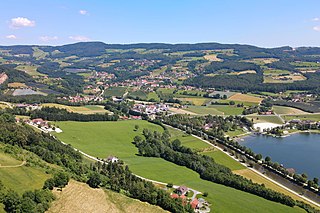
Stubenberg, called Stubenberg am See, is a municipality in the district of Hartberg-Fürstenfeld, in Styria, Austria. It is located roughly 50 km from Graz and 200 km from Vienna. It has a population of 2.287 as of April 2010.
The Western Railway is a two-track, partly four-track, electrified railway line in Austria that runs from Vienna to Salzburg via St. Pölten and Linz Hauptbahnhof and is one of the major lines of Austria. It was originally opened as the Empress Elisabeth Railway in 1858 (Vienna–Linz). The line is owned and operated by Austrian Federal Railways (ÖBB).

Palais Porcia is a former urban residence in the western quarter of the Innere Stadt of Vienna, Austria. It stands at 23, Herrengasse between Palais Kinsky and Palais Trautmansdorff and across Palais Harrach. The palace was built in 1546 for the descendants of Count Gabriel von Salamanca-Ortenburg. It was representative of the simple Renaissance style that emerged in Vienna in the middle of the 16th century. In the 17th and later centuries it was extensively remodelled in Baroque and Rococo styles but the inner court still contains an early Renaissance arcade. As of 2010, Palais Porcia houses the Administrative Library of the Austrian Federal Chancellery.
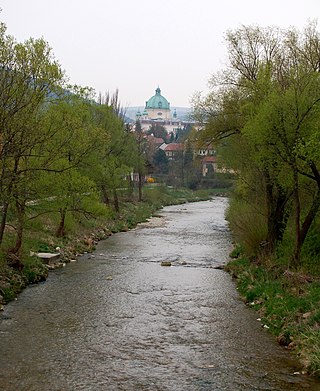
The Triesting is a river of Lower Austria, in the southeastern part of the Vienna Woods. Its drainage basin is 388 km2 (150 sq mi).

Stiftsgymnasium Melk is a Roman Catholic Benedictine-run gymnasium located in Melk, Austria. The gymnasium is located within and run by the well-known monastery Melk Abbey. Founded in the 12th century as a monastic school, it is also the oldest continuously operating school in present-day Austria.

The Wachau is an Austrian valley with a picturesque landscape formed by the Danube river. It is one of the most prominent tourist destinations of Lower Austria, located midway between the towns of Melk and Krems that also attracts "connoisseurs and epicureans" for its high-quality wines. It is 36 kilometres (22 mi) in length and was already settled in prehistoric times. A well-known place and tourist attraction is Dürnstein, where King Richard I of England was held captive by Leopold V, Duke of Austria. The architectural elegance of its ancient monasteries, castles and ruins combined with the urban architecture of its towns and villages, and the cultivation of vines as an important agricultural produce are the dominant features of the valley.

Schallaburg Castle is a castle in the village of Schallaburg in the municipality of Schollach, near the Wachau valley, Lower Austria, north of the Alps. Schallaburg Renaissance Castle is 5 kilometres (3 mi) from Melk, in the region known as Mostviertel. The central part of the castle was built in the German Renaissance Age, beginning around 1540, by the Losenstein dynasty.

Gundakar of Liechtenstein was a member of the House of Liechtenstein and as such the owner of a large estate. He also served the Habsburg dynasty.






















